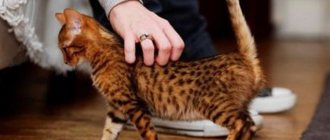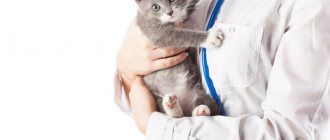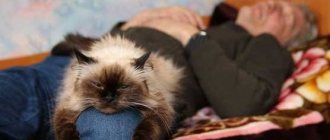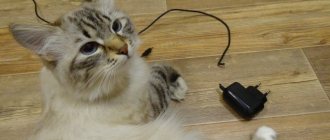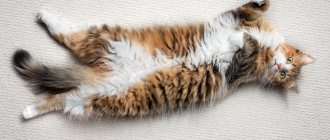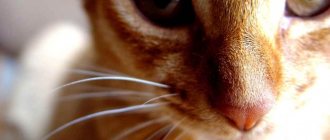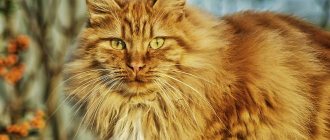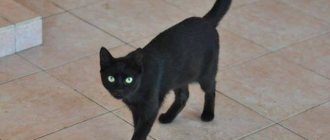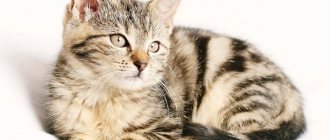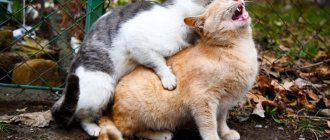Cats and dogs have their own individual characteristics and character. Cats, especially, strive to express themselves by imitating humans. To do this, they have many possibilities - ears, eyes, paws, mustaches and of course the tail. You can understand the language of cats by familiarizing yourself in detail and studying the signals that the pet tries to convey to its owner.
How to understand a cat's language by looking at its tail
In the course of research conducted by scientists from different countries, it became known that cats are capable of making over 60 different sounds. Thus, cats can vibrate in a variety of ways and also express their emotional state through body language.
The most powerful pointer in cats is the tail. Unlike a dog, a cat's tail is much more mobile and serves as a kind of balancer.
In addition, the tail of cats is an indicator of mood. A sharply raised tail, pointing straight upward, means great enthusiasm, greeting and expression of joy. Such a signal can be intended not only for the owner who has returned from work, but also for his relatives whom the cat has met on the street. The greeting involves not only the tail, but also the bend of the body and a soft purr.
The following states of a cat can be determined by the tail:
- A drooping tail means the cat feels frightened or slightly displeased. In such cases, it is better to leave the animal alone.
- Twitching of the tail or sharp swings indicate a degree of nervousness. The cat wants to be alone and it’s best not to disturb it. In this case, the animal does not intend to enter into a discussion with its owner.
- Twitching the tip of the tail is a manifestation of strong concern. The animal understands human speech and may show dissatisfaction about this if it hears unflattering reviews about itself.
- The raised hair on the tail is a sign of intense rage and undisguised anger. The cat is preparing to attack.
- A tucked tail between the hind legs is a feeling of fear.
Head and mustache
Head raised . The meaning of this gesture varies depending on the circumstances. If the cat is happy, a raised head indicates curiosity and confidence, and is usually combined with perked ears. On the other hand, if he is in a confrontation with another cat, a raised head indicates dominance and in this case the ears will be flat against the head.
Head down . When confronting another cat, a lowered head indicates submission. In other circumstances, a lowered head may indicate sleepiness, contentment, or boredom.
Cat's whiskers . Whiskers can serve as an indicator of a cat's mood. If the whiskers are forward, the cat is relaxed, content, or curious. If they are pulled back, the cat is preparing to defend itself or attack.
Communication using limbs
If a pet gently moves its furry paws and at the same time releases its claws, then the animal is content and in a state of complete peace. Being in a good mood and feeling bliss, cats begin to mentally return to their early years. As a small kitten, the animal sucked its mother's milk and kneaded her belly with its paws. In addition to moving its paws, the cat begins to purr gently and soothingly.
Note! In such moments of bliss, the cat can forget itself and begin to release its claws, digging into the owner’s body. It is not recommended to scold or sharply pull your pet, as this can greatly offend an impressionable animal. It is best to carefully move the cat and pet it.
Very often, cats show their love for their owner by gently hugging them with their paws. But if the paw is raised sharply upward, with its claws extended, it means that the cat is preparing to defend itself and is determined.
Fracture or dislocation
The cat's tail is part of the spine. It consists of bones, so sometimes dislocations and even fractures of this part of the body occur. This happens, for example, if an animal falls from a height or gets its tail pinched by a door.
Watch your pet carefully. If he does not sit down completely, but holds his tail between his paws, this means that the animal is experiencing pain. Damage to the spine is fraught with serious irreversible consequences, because the spinal cord also suffers. Therefore, immediately take the injured four-legged animal to the veterinarian for examination. Only a specialist will be able to establish an accurate diagnosis using x-rays and prescribe the necessary treatment in a timely manner. You won't be able to help your pet on your own.
Expressing emotions using ears and eyes
Cats' ears are excellent radars, designed to detect various sound waves. It is noteworthy that a cat in a state of wakefulness can detect the sound made by rodents at a distance of more than 20 meters. In search of a sound source, a cat can rotate its ear 180 degrees. More than 30 different muscles are involved in the ear's unique ability to bend, press, and rotate.
There are a number of emotions expressed through the position of the ears:
- A cat can express a good mood and positive attitude using its ears. In this case, they will be strictly in front at the top of the head.
- The placement of the ears in different directions or flat means that the cat is at a loss, not understanding what is happening.
- Dropped or pinned ears are a signal to attack; the pet is ready to defend itself and it is better to leave it alone.
- Ears turned and pressed back are a sign of rage and anger.
- Twitching ears means that the cat is nervous and irritated. This movement is often observed when the pet is watching a potential victim.
It’s not just a cat’s ears that can indicate the animal’s mood. The visual organ – the eyes, like people’s – can express a whole range of emotions. When a pet looks with an open, calm gaze, it means that she is happy with everything or is interested in the action taking place. There is an opinion among breeders and cat lovers that with the help of a look a cat can express its love for its owner. In this case, the animal looks straight into the eyes of its owner for a long time and devotedly, and then slowly closes its eyes.
How to understand a cat by meowing
By meowing you can understand the whole spectrum of emotions felt by a cat. Cats express most of their emotions through gestures or facial expressions. Cats use sounds to emphasize their state or the emotions they are experiencing. In most cases, cats purr. This is a special sound created not by all vocal cords, but by vibrations in the upper register. The main purpose of purring is to express peace and love for the owner.
Note! Some owners note that the cat begins to purr, expressing its dissatisfaction or resentment.
A cat can not only purr, but also hiss, howl, chirp and make crackling sounds.
- Short cooing-like sounds are made by cats after a hearty meal, as well as while being stroked by their owner or in anticipation of a treat.
- Hissing means that the animal does not want to make contact, is very frightened and is ready to attack.
- howl and grumble during the onset of hunting. The animal shows its condition and calls the opposite sex.
- By meowing in high notes , a cat or cat is trying to attract its owner or a stranger.
- Specific sounds of chirping and crackling can be made by cats calling their grown kittens.
- But when a cat purrs with its mouth closed , it means full readiness for procreation.
Cats can produce many different sounds, differing in pitch, length and sound timbre. They are all different, but in most cases, loud sounds emitted express negative emotions, while soft and quiet ones indicate good spirits and mood.
If the animal begins to scream, making heartbreaking sounds, then this indicates that the cat requires help. Perhaps something hurts her. In addition, sharp, intense sounds made by an animal indicate a feeling of fear or anger.
Dictionary of cat sounds
Purring - calmness. Dissatisfied purring is a painful sensation. Rumbling is dissatisfaction. Meowing is a greeting and sometimes a request. An intermittent meow, similar to a squeal, is a response to human treatment. Howling is anger. A short cry is fear. Muffled purring, ending with a dissatisfied rumbling - patience has run out. Hissing is a readiness for defense, a warning about this. The restrained purr of a nursing cat is a warning to kittens about possible danger. The same thing, ending with a raised tone - a warning to a person or other creatures not to approach the kittens.
Cat sign language
Cats and kittens can express their attitude and emotional state not only with the help of their ears and voice. With the help of body language, cats can show their friendly attitude, humility, peace, arrogance, resentment and other emotions.
Having shouted or offended his pet in some other way, a person notices that the cat turns its whole body in the opposite direction from him, not paying attention to calls and appeals. Experts say that this is not so much an indicator of arrogance and arrogance as a fear of meeting the eyes of an angry owner.
When a cat shows its belly , it is a signal of a friendly attitude and a special degree of trust. The animal is in a good, playful mood and will, with great pleasure, allow itself to be stroked and cuddled.
In cases where a cat arches its back and raises the hair on its nape and tail, we can confidently say that the animal is ready for an attack and a fierce battle. On the contrary, if the pet tries to hug the floor, bend its ears and tail in order to appear visually smaller, it means that the cat does not intend to communicate and wants to be left alone.
Why can a cat lower its butt while stroking it?
When, while stroking, a cat begins to stick out the back of its body, crawl closer, and squint its eyes, it thus demonstrates the highest level of its pleasure.
It happens that the owner begins to stroke the cat, and he wags his tail and meows. This means that he does not like stroking or the cat is not in the mood for affection at the moment.
If a cat sits and wags its tail, it is in a good mood. If you start petting him at this moment, he will immediately arch his butt and press his ears. Rocking on the floor can also be an invitation to play. However, you need to be careful here, because there may be other reasons for this behavior.
If a cat walks and suddenly stops, stomping around in one place, it means it’s time for him to sleep. This is the place he chose to rest. If the cat lies peacefully, and after stroking it begins to bite and fight, it is inclined to play with the owner.
Communication by smells
At first glance, it may seem that we are talking about marking territorial boundaries. But this is not entirely true, because there is also a secret type of communication between a pet and its owner using smells.
The most important aromas with which a cat establishes contact with its owner are the elusive odors left by the animal on a person with the help of specific glands located on the chin, forehead and lips.
These glands produce special odors used for greeting (a cat pokes its face after a long absence of its beloved owner). Cats often rub against the owner’s legs, leaving as much odor as possible on the owner’s clothes, and they also rub their muzzle into the person’s face and hands in order to leave more odor on the skin.
After such secret manipulations, a person receives a whole spectrum of specific odors that accompanies him everywhere. Cats believe that the owner also marked them when he stroked their fur or head, leaving their scent in return as a sign of devotion and love.
